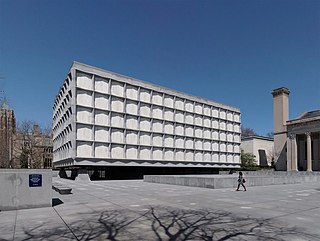
The Beinecke Rare Book & Manuscript Library is the rare book library and literary archive of the Yale University Library in New Haven, Connecticut. It is one of the largest buildings in the world dedicated to rare books and manuscripts and is one of the largest collections of such texts. Established by a gift of the Beinecke family and given its own financial endowment, the library is financially independent from the university and is co-governed by the University Library and Yale Corporation.

A mezzanine is an intermediate floor in a building which is partly open to the double-height ceilinged floor below, or which does not extend over the whole floorspace of the building, a loft with non-sloped walls. However, the term is often used loosely for the floor above the ground floor, especially where a very high-ceilinged original ground floor has been split horizontally into two floors.
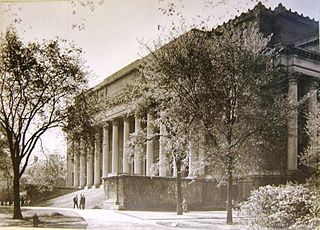
The Harry Elkins Widener Memorial Library, housing some 3.5 million books in its "vast and cavernous" stacks, is the centerpiece of the Harvard College Libraries and, more broadly, of the entire Harvard Library system. It honors 1907 Harvard College graduate and book collector Harry Elkins Widener, and was built by his mother Eleanor Elkins Widener after his death in the sinking of the RMS Titanic in 1912.
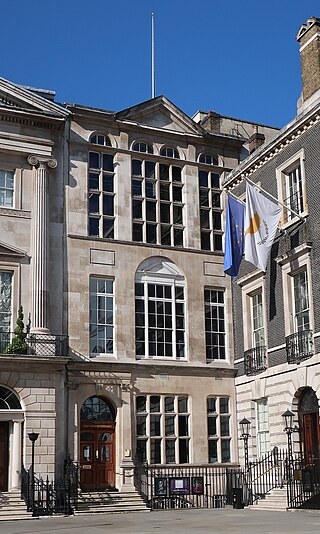
The London Library is an independent lending library in London, established in 1841. It was founded on the initiative of Thomas Carlyle, who was dissatisfied with some of the policies at the British Museum Library. It is located at 14 St James's Square, in the St James's area of the City of Westminster, which has been its home since 1845. Membership is open to all, on payment of an annual subscription, and life and corporate memberships are also available. As of December 2021 the Library had over 7000 members.

A bookcase, or bookshelf, is a piece of furniture with horizontal shelves, often in a cabinet, used to store books or other printed materials. Bookcases are used in private homes, public and university libraries, offices, schools, and bookstores. Bookcases range from small, low models the height of a table to high models reaching up to ceiling height. Shelves may be fixed or adjustable to different positions in the case. In rooms entirely devoted to the storage of books, such as libraries, they may be permanently fixed to the walls and/or floor.

Manchester Central Library is the headquarters of the city's library and information service in Manchester, England. Facing St Peter's Square, it was designed by E. Vincent Harris and constructed between 1930 and 1934. The form of the building, a columned portico attached to a rotunda domed structure, is loosely derived from the Pantheon, Rome. At its opening, one critic wrote, "This is the sort of thing which persuades one to believe in the perennial applicability of the Classical canon".

Sterling Memorial Library (SML) is the main library building of the Yale University Library system in New Haven, Connecticut, United States. Opened in 1931, the library was designed by James Gamble Rogers as the centerpiece of Yale's Gothic Revival campus. The library's tower has sixteen levels of bookstacks containing over 4 million volumes. Several special collections—including the university's Manuscripts & Archives—are also housed in the building. It connects via tunnel to the underground Bass Library, which holds an additional 150,000 volumes.

An automated storage and retrieval system consists of a variety of computer-controlled systems for automatically placing and retrieving loads from defined storage locations. Automated storage and retrieval systems (AS/RS) are typically used in applications where:
Angus Snead Macdonald (1883-1961) was an American architect and businessman; from 1915 to 1952 the president of Snead and Company. This company, based in Louisville, Kentucky, manufactured the cast iron book stacks found in libraries all over the world in the beginning of the 20th century including the Washington DC Public Library and Harvard's Widener Library. After World War I Angus Snead Macdonald would lead Snead and Company to revolutionize and standardize library book stacks.

The D. H. Hill Jr. Library is one of two main libraries at North Carolina State University. It is the third building to house the NC State University Libraries, following Brooks Hall and Holladay Hall. The current building, situated on the Hillsborough Street edge of North Campus, is the result of four stages of construction, and houses the majority of the volumes in NC State's collection.

Pallet rack is a material handling storage aid system designed to store materials on pallets. Although there are many varieties of pallet racking, all types allow for the storage of palletized materials in horizontal rows with multiple levels. Forklift trucks are usually required to place the loaded pallets onto the racks for storage. Since the Second World War, pallet racks have become a ubiquitous element of most modern warehouses, manufacturing facilities, retail centers, and other storage and distribution facilities. All types of pallet racking increase storage density of the stored goods. Costs associated with the racking increases with increasing storage density.

The Stephen A. Schwarzman Building is the flagship building in the New York Public Library system in the Midtown Manhattan neighborhood of New York City. The branch, one of four research libraries in the library system, contains nine separate divisions. The structure contains four stories open to the public. The main entrance steps are at Fifth Avenue at its intersection with East 41st Street. As of 2015, the branch contains an estimated 2.5 million volumes in its stacks. The building was declared a National Historic Landmark, a National Register of Historic Places site, and a New York City designated landmark in the 1960s.

Mobile shelving, mobile aisle shelving, compactus,roller racking, or rolling stack, are terms applied to shelving or storage units fitted with wheeled traction systems. Units can be closely packed when access is not required, but can be readily moved to open up an aisle to allow access. By eliminating the need for a permanently open aisle between every unit, a smaller proportion of floor space can be allocated to storage than in the case of conventional fixed shelving, or a higher capacity of storage can be met using the same footprint as fixed shelving.

The Carnegie Library of Reims is a public library built with money donated by businessman and philanthropist Andrew Carnegie to the city of Reims after World War I. Reims was one of three "front-line" cities to be given a Carnegie library, the other two being Leuven and Belgrade. Built in the 1920s, it combined the mission of heritage conservation and of reading public library. Until 2003, the Carnegie Library was the main library of Reims.

An adjustable shelf is a shelf that can be adjusted according to needs. The most common variant is that the height intervals can be adjusted to accommodate various items. This allows more flexible use to hold items of value for storage, display or sale. Like fixed shelves, the horizontal planes are normally made of strong materials such as wood or steel, but their exact vertical positioning can be varied - usually through the use of uprights into which supporting brackets or the shelves themselves can be fixed at different heights.

The Main Library is a historic library on the campus of the University of Illinois Urbana-Champaign in Urbana, Illinois. Built in 1924, the library was the third built for the school; it replaced Altgeld Hall, which had become too small for the university's collections. Architect Charles A. Platt designed the Georgian Revival building, one of several on the campus which he designed in the style. The building houses several area libraries, as well as the University Archives and the Rare Book & Manuscript Library. The Main Library is the symbolic face of the University Library, which has the second largest university library collection in the United States.
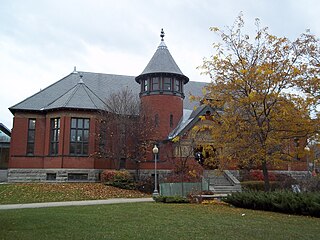
Westmount Public Library (WPL) is located at 4574 Sherbrooke Street West, Westmount, Quebec, Canada, in the northwest corner of Westmount Park. Designed by Robert Findlay, it opened in 1899.

Pratt Institute Libraries is the academic library system of Pratt Institute. The main library is located on the main campus in Brooklyn, NY, with a branch library in Manhattan. The collection focus includes the arts, architecture, design, information science and allied fields. Holdings include 200,000 printed volumes, over 600 periodicals, rare books, digital images resources including Pratt Institute specific Digital Image Collection, and the Institute's archives. It has the distinction of being the “first free public library in Brooklyn” and its Brooklyn building is a New York City designated landmark.
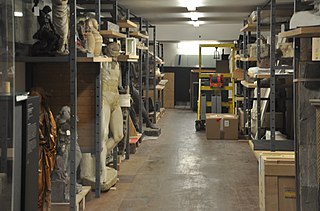
The cultural property storage typically falls to the responsibility of cultural heritage institutions, or individuals. The proper storage of these objects can help to ensure a longer lifespan for the object with minimal damage or degradation. With so many different types of artifacts, materials, and combinations of materials, keepers of these artifacts often have considerable knowledge of the best practices in storing these objects to preserve their original state.





















